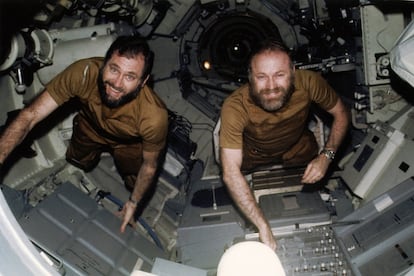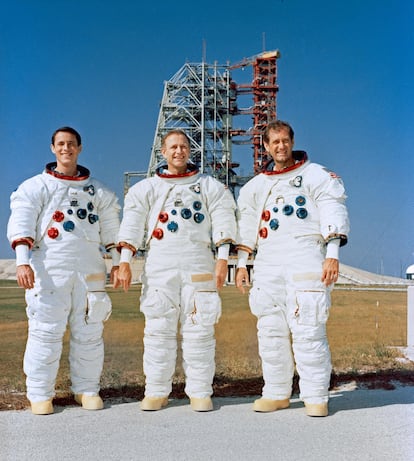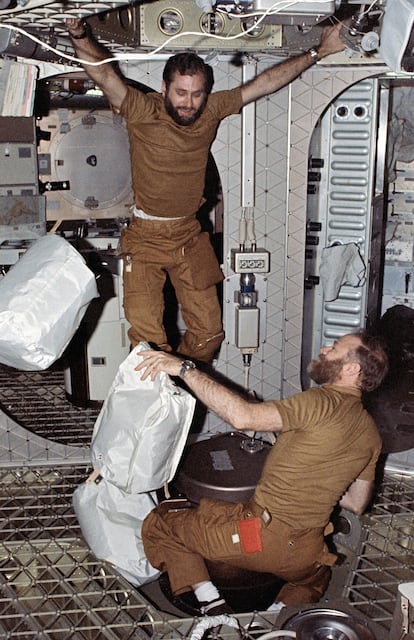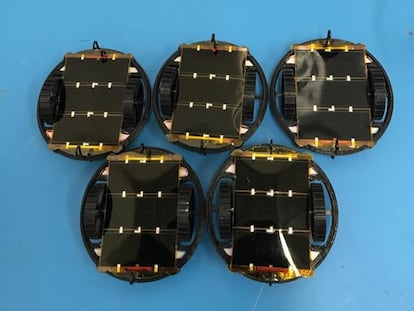Skylab 4: 50 years since the first ‘mutiny’ aboard a spacecraft
American astronauts pressured commanders to reassess their workload, though the episode has been exaggerated

There have been at least two cases of rebellion by astronaut crews in the history of space exploration. The first happened in 1968 during the Apollo 7 mission. Commander Wally Schirra had come down with a cold and fever, and his congested sinuses led him to ignore the reentry protocol. Schirra and the crew chose not to wear their helmets, fearing ruptured eardrums due to the pressure change. The second incident happened during the Skylab 4 mission (1973-1974), which was the final tour aboard the NASA space laboratory.
The Soviet Union already had a space station, Salyut 1 (which tragically ended in the deaths of its crew during reentry), and had just launched their second one into orbit. Meanwhile, NASA engineers repurposed an empty third stage of the Saturn V moon rocket to house a space station called Skylab. The shell enabled various experiments, including studying organism behavior in microgravity and testing new materials processing techniques. Skylab also had a solar telescope and amenities like individual bedrooms, a small kitchen, and a shower.
The laboratory’s launch — Skylab 1 — didn’t go smoothly. A strong gust of wind damaged its insulating, anti-meteorite shield, and one of its solar panels. The second panel was undamaged but got stuck in a closed position. The primary focus of the first mission — Skylab 2 — was to install a new protective shield and restore the space station to normal operation.
Skylab 3 focused on repairs and conducted a wide range of experiments. One of the notable studies involved observing how spiders create webs in weightlessness. This mission lasted 59 days, which was more than twice as long as the previous one.

Skylab 4 was entrusted to a trio of rookie astronauts: Gerald Carr (mission commander), William Pogue (pilot) and Edward Gibson (science pilot). None had prior space experience, which was a crucial aspect of this story. The goal was to complete a nearly three-month stay. As the final Skylab mission, the work schedule was demanding. Adding to the challenge, the unexpectedly active Sun required more telescope observations.
The astronauts were given orders to start working immediately, leaving them little time to adjust to the new feeling of weightlessness. They experienced long episodes of dizziness and vomiting, but chose to conceal this from mission control. When their conversations about the nausea were overhead by mission control, Alan Shepard, the legendary Chief of the Astronaut Office, issued the first official reprimand of a crew during a space mission.
The mission got off to a rough start. Perhaps affected by the reprimand, the astronauts started making small mistakes and falling behind in their experiment program. It didn’t help that Houston was trying to micromanage every minute detail, which frustrated the three men.
Normally, it takes a few years to prepare for a program of experiments in space. NASA wanted to leverage the last Skylab mission, so they solicited experiment proposals just a few months before launch. Hundreds poured in. As a result, researchers on the ground had to constantly guide the overwhelmed astronauts due to all the unresolved loose ends.

The Skylab 4 crew received 40 pages of instructions every day, covering everything from aiming the telescope to watering the bean seedlings. Every morning, Carr, Pogue and Gibson were greeted by six feet of teletype printouts with guidelines, formulas and procedures to be executed in the next 24 hours.
Pogue would later say that the schedule was particularly demanding due to the focus on astrophysics experiments. “They gave you a certain time and certain angles and so forth, and you’d get that certain star. Well, if you don’t do that on time, the angles and everything don’t do any good. I mean, they’re passé.”
Intolerable living conditions
The first two Skylab crews had a relatively positive experience, but the third crew did not. A number of small but frustrating inconveniences piled up. The food cans didn’t fit in the warmer, so all the food was lukewarm. The towels for personal hygiene felt rough. The drinking water had dissolved gas bubbles, causing constant burping. And the low atmospheric pressure meant the astronauts had to shout to communicate, even at relatively short distances. Astronauts developed nasal congestion in zero gravity, causing blocked sinuses and making their food tasteless.
However, what frustrated the Skylab 4 crew the most was the lack of organization. It seems that the previous crews were not diligent in maintaining order, even though good inventory management was crucial for keeping track of Skylab’s 40,000 items stored in 100 cabinets. At Houston mission control, six people and a computer tracked the location of everything, but in reality, chaos had taken hold on the space station. To make matters worse, there was no lighting inside the storage cabinets. To find any item, like a camera or toothpaste, they had to search through drawers using a flashlight.
All these little things slowed the work and experiments fell behind schedule. The astronauts were commanded to take shorter rest periods, and they began to work 16-hour shifts, leaving only six hours for sleeping. Often, a single experiment, such as photographing solar activity or the new Kohoutek comet, lasted three to four hours.

On Christmas Day, Skylab’s path took it beyond the reach of tracking stations for a full orbit, leading to later rumors that the astronauts had turned off their radio. But Carr and Pogue were actually conducting a demanding seven-hour spacewalk on that day. When Houston casually suggested a break, they did so and Carr joked they would then “turn on the answering machine.”
Radio silence
“One of the things we did is we got careless with our radios and we forgot to configure for one of our passes,” said Carr, “so when we went over one of the signal sites, people on the ground called us and we didn’t answer them.” But the media reports at the time said the crew had refused to speak with ground control.
The crew and mission control eventually held a conference to air their concerns and reached a consensus on the way forward, which included prioritizing key research and putting routine tasks on a “shopping list” to be completed at any time during the day.
“That opened up the schedule, took all the pressure off. We were no longer racing the clock to get things done. That really solved the problem,” Carr recalled. “The loosening of the schedule allowed us to get their more important experiments done, and the rest of the stuff got done when we could, instead of on a real tight schedule. It worked out beautifully.”
The astronauts had several tense discussions with mission control about the need to revise their work program. Eventually, their demands were met, and months later, a flight director admitted that the crew had been under excessive pressure. This experience led to several conclusions, including the importance of human factors and the need to have at least one experienced astronaut on every mission.
In August 1976, Henry Cooper, a respected journalist covering NASA’s space program, wrote an article in The New Yorker suggesting that the stressed Skylab 4 astronauts had gone on strike for a day. When Cooper’s book about Skylab, A House in Space, was published later that year, he characterized the astronaut’s day off as a “mutiny.” The legend of the three mutineers persisted for years, adding a touch of color to NASA lore.
NASA’s history division recently published the official account of Skylab’s final mission, citing recorded conversations and the extensive work done by the Skylab 4 crew. At 87 years old, Ed Gibson is the only living member of the team. Despite the crew’s successful completion of all scheduled experiments (and even some additional ones), Gibson said it’s still disheartening that the “mutiny” remains the public’s main memory of their 84 days in space.
Sign up for our weekly newsletter to get more English-language news coverage from EL PAÍS USA Edition
Tu suscripción se está usando en otro dispositivo
¿Quieres añadir otro usuario a tu suscripción?
Si continúas leyendo en este dispositivo, no se podrá leer en el otro.
FlechaTu suscripción se está usando en otro dispositivo y solo puedes acceder a EL PAÍS desde un dispositivo a la vez.
Si quieres compartir tu cuenta, cambia tu suscripción a la modalidad Premium, así podrás añadir otro usuario. Cada uno accederá con su propia cuenta de email, lo que os permitirá personalizar vuestra experiencia en EL PAÍS.
¿Tienes una suscripción de empresa? Accede aquí para contratar más cuentas.
En el caso de no saber quién está usando tu cuenta, te recomendamos cambiar tu contraseña aquí.
Si decides continuar compartiendo tu cuenta, este mensaje se mostrará en tu dispositivo y en el de la otra persona que está usando tu cuenta de forma indefinida, afectando a tu experiencia de lectura. Puedes consultar aquí los términos y condiciones de la suscripción digital.
More information
Archived In
Últimas noticias
NASA discovers Titan doesn’t have an ocean, but a ‘slushy ice layer’ that increases possibility of life
Innocence lost in the forest of the child soldiers: ‘Each leader of the armed group had his girls’
‘Fallout’ or how the world’s largest company turned an anti-capitalist apocalyptic Western into a phenomenon
From inflation to defending migrants: Eileen Higgins and Zohran Mamdani inaugurate the new Democratic resistance against Trump
Most viewed
- ‘El Limones’ and the growing union disguise of Mexican organized crime
- Christian Louboutin: ‘Young people don’t want to be like their parents. And if their parents wear sneakers, they’re going to look for something else’
- The low-cost creative revolution: How technology is making art accessible to everyone
- ‘We are dying’: Cuba sinks into a health crisis amid medicine shortages and misdiagnosis
- A mountaineer, accused of manslaughter for the death of his partner during a climb: He silenced his phone and refused a helicopter rescue











































